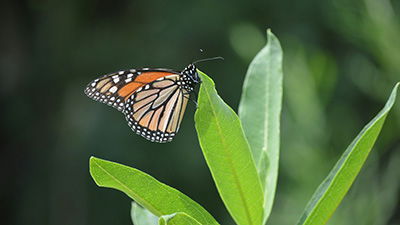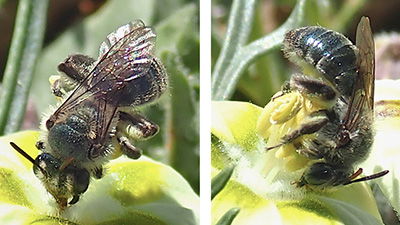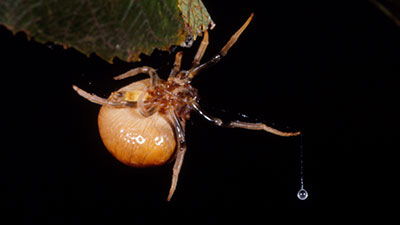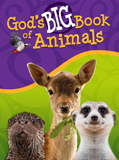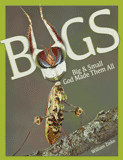
Snails, Slugs, and Semi Slugs: A Perfect Evolutionary Transition?
Carnegie Museum biologist suggests a new evolutionary history for snails and slugs but fails to account for differences in anatomy and lack of evidence.
A recent article from the Carnegie Museum of Natural History made some very interesting claims about the evolutionary history of snails, slugs, and semi-slugs. According to the article, slugs evolved from snails by passing through a semi-slug stage.1 A semi-slug is a snail with an external shell too small to accommodate the entire organism. There are, as usual, large-scale problems with this evolutionary claim.
Before getting into all the problems with the evolutionary story, there are a few important points to consider. First, from a creationist perspective, there are likely multiple kinds of slugs, semi-slugs, and snails, each with their own unique diversification histories. Therefore, any effort to discuss their diversification will of necessity be very general and broad. It is further important to point out that the evolutionists have not, as best I can determine, offered a mechanistic explanation for the reduction of a snail’s shell into a slug’s shell beneath the skin. Instead, what we tend to get is analyses of either morphological diversity2 or phylogenetic trees.3 Neither substitutes for a step-by-step, mechanistic, genetic explanation for how evolution could convert an external shell to an internal one, nor does it explain the numerous other changes required to go from a snail to a slug.
While snails and slugs are superficially similar, their internal anatomy is quite different.
While snails and slugs are superficially similar, their internal anatomy is quite different. This quotation illustrates the number of changes required to go from a snail to a slug:
Reduction and loss of the shell is necessarily accompanied by changes in the mantle cavity, the excretory system, the free muscle system, the arrangement of the heart and respiratory surfaces, and by a reduction of the visceral hump with major reorganization of the internal organs.4
While the above author argues that these changes occurred, think for a moment about what would be required. For example, rice grain shape is affected by more than 400 QTLs (quantitative trait loci)—a point in the genome that influences a phenotypic trait.5 Yield rate in bread wheat is controlled by 55 such QTLs.6 Seventy-five loci affect human red blood cells.7 These are just a few examples. While changing one of these loci will change the trait at least slightly, to change the entire structure of the trait would require changing most if not all the loci. That requires mutations, lots of them, and they must be beneficial. The problem is that the vast majority if not the entirety of mutations observed are deleterious.8
How Now, Brown Snail?
What the above indicates is that changing from a snail to a slug requires a ton of DNA changes. These changes must be beneficial if they are to proliferate in a population. Yet the evolutionists themselves admit that beneficial mutations are vanishingly rare, and when they occur, they have minute effects.9 This makes the wholesale reorganization of the snail into a slug unlikely to happen even once. Yet according to evolutionists, it happened at least a dozen separate times.10
According to the evolutionary story, semi-slugs are a transitional state between snails and slugs. This argument, however, raises significant problems beyond the morphology problem posed by the number of genetic changes required to morph from a snail to a slug. Both snails and slugs have adaptive advantages that make them well suited to their environments. Yet as one evolutionist admits, semi-slugs have none of the advantages and all the disadvantages: “[S]emi-slugs seem to have all disadvantages: no protection from predators or drying out, a need for calcium, and can’t fit into tiny hidey holes. Semi-slug score: 0 advantages, 4 disadvantages.”11 Other evolutionists have made similar claims about the semi-slugs being an “inferior transitional stage between shelled snails and slugs.”12 Yet somehow there are more semi-slugs to slugs by a ratio of 2:1.13
It could potentially be argued here that disruptive selection might play a role in moving a snail to a slug through the semi-slug pathway. Disruptive selection occurs when natural selection favors the extreme ends of a phenotype.14 Thus in this scenario, the slugs and the snails would be the extremes and the semi-slugs in the middle. However, this assumes that snail, semi-slug, and slug morphs already existed in an ancestral population. It does not explain their origin. Nor does it explain how semi-slugs persist when they are evolutionarily disfavored.15 These facts eliminate selection as a potential explanation for the significant number of differences between snails and slugs.
These facts eliminate selection as a potential explanation for the significant number of differences between snails and slugs.
Maybe They Were Feeling Sluggish?
Evolutionists have claimed that the trend among snails is the reduction in shells and therefore evolution toward slugs in at least some cases.16 Even if this claim were true, there is a significant problem. The loss of a shell is not the kind of evolution that is required to fit the evolutionary narrative. It represents what is termed reductive evolution. Reductive evolution occurs when a gene or trait is lost from a population as occurs when Staphylococcus bacteria go from free living to host-specific bacteria.17 In the Staph bacteria, a specific domain found in some proteins is lost; in the semi-slug, the shell is reduced. Losing a shell or a protein domain does not provide a new trait; rather, it represents the loss of existing traits.
What evidence, then, of evolution, do the evolutionists have that snails evolved into slugs by means of semi-slugs? Outside of phylogenetic trees, which make for great graphics but poor explanations, evidence is sparse.18 Most of the articles about snail evolution are about variation within a species or within a genera of snails, often involving shell shape19 or even color morph.20 Variation in color and shell shape are perfectly compatible with a creationist model of variation within created kinds.
Because snails, slugs, and semi-slugs were likely not on Noah’s ark, at least as intended passengers, they likely survived the flood in higher numbers than many of the ark kinds.
Conclusion
Because snails, slugs, and semi-slugs were likely not on Noah’s ark, at least as intended passengers, they likely survived the flood in higher numbers than many of the ark kinds (not limited to only pairs or at most seven pairs, and they could have survived or “hitched a ride” in the same way insects would have). This higher number could have increased genetic diversity in the post-flood snail, semi-slug, and slug populations. This extra diversity might help explain why there are so many varieties of each today. Further, gene dosage might play a role in phenotypic diversity, as is known in some polyploid snails.21 Differential gene expression is also known among populations in different habitats, which could indicate a role in diversification as well.22 Epigenetic changes in response to habitat changes, as occurs in some species shell shape, is also possible.23
In short, snails, slugs and semi-slugs show no evidence of large-scale evolutionary changes that turn a snail into a slug. In some cases, a semi-slug might be the result of a snail undergoing small-scale adaptation by losing traits, but according to the available evidence, slugs and snails are distinct. Diversity does exist within the likely numerous created kinds of the three, and that diversity can be caused by a variety of mechanisms acting in tandem or alone. While diversification has occurred, the diversification is limited and has not bridged the significant gap between snails, slugs, and semi-slugs.
Footnotes
- Timothy A. Pearce, “What’s So Good about Being a Slug?” Carnegie Museum of Natural History, accessed October 7, 2021, https://carnegiemnh.org/whats-so-good-about-being-a-slug/.
- Geerat J. Vermeij, “Gastropod Evolution and Morphological Diversity in Relation to Shell Geometry,” Journal of the Zoological Society of London 163 (1971): 15–23, doi:10.1111/j.1469-7998.1971.tb04522.x.
- Christopher M. Wade et al., “A Phylogeny of the Land Snails (Gastropoda: Pulmonata),” Proceedings of the Royal Society of London B, 268 (2001): 413–422, doi:10.1098/rspb.2000.1372.
- D. W. Burton, “How to Be Sluggish,” Tuatara 25, no. 2 (1982): 48–63, http://www.nzetc.org/tm/scholarly/tei-Bio25Tuat02-t1-body-d2.html.
- Rongyu Huang et al., “Genetic Bases of Rice Grain Shape: So Many Genes, So Little Known,” Trends in Plant Science 18, no. 4 (2013): 218–226, doi:10.1016/j.tplants.2012.11.001.
- L. Y. Zhang et al., “Genomic Distribution of Quantitative Trait Loci for Yield and Yield-related Traits in Common Wheat,” Journal of Integrative Plant Biology 52, no. 11 (2010): 996–1007, doi:10.1111/j.1744-7909.2010.00967.x.
- John. C. Chambers et al., “Seventy-Five Genetic Loci Influencing the Human Red Blood Cell,” Nature 492 (2012): 369–375, doi:10.1038/nature11677.
- Thomas Bataillon, “Estimation of Spontaneous Genome-wide Mutation Rate Parameters: Wither Beneficial Mutations?,” Heredity 84 (2000): 497–501, doi:10.1046/j.1365-2540.2000.00727.x..
- Lilia Perfeito et al., “Adaptive Mutations in Bacteria: High Rate and Small Effects,” Science 317, no. 5839 (2007): 813–815, doi:10.1126/science.1142284.
- Pearce, “What’s So Good about Being a Slug?”
- Pearce, “What’s So Good about Being a Slug?”
- Bernhard Hausdorf, “Macroevolution in Progress: Competition Between Semislugs and Slugs Resulting in Ecological Displacement and Ecological Release,” Biological Journal of the Linnean Society 74, no. 3 (2001): 387–395, doi:10.1111/j.1095-8312.2001.tb01400.x.
- Burton, “How to Be Sluggish.”
- Claus Rueffler et al., “Disruptive Selection and Then What?” TRENDS in Ecology and Evolution 21, no. 5 (2006): 238–245, doi:10.1016/j.tree.2006.03.003.
- Loren H. Rieseberg et al., “Directional Selection Is the Primary Cause of Phenotypic Diversification,” Proceedings of the National Academy of Sciences USA 99, no. 19 (2002): 12242–12245, doi:10.1073/pnas.192360899.
- Anatoly A. Schileyko, “Functional Interrelations Between Conchological and Anatomical Characters in Stylommatophora (Mollusca, Gastropoda),” Archives of Zoological Museum of Lomonosov Moscow State University 54 (2016): 269–297, https://zmmu.msu.ru/files/aspects_biodiv/12_shileyko.pdf.
- Greg A. Somerville et al., “Reductive Evolution and the Loss of PDC/PAS Domains from the Genus Staphylococcus,” BMC Genomics 14, no. 524 (2013): doi:10.1186/1471-2164-14-524.
- Leila Belen Guzman et al., “The Mitochondrial Genome of the Semi-Slug Omalnyx unguis (Gastropoda: Succineidae) and the Phylogenetic Relationships within Stylommatophora,” PLOS One (2021), doi:10.1371/journal.pone.0253724.
- Takahiro Hirano et al., “Divergence in the Shell Morphology of the Land Snail Genus Aegista (Pulmonata: Bradybaenidae) under Phylogenetic Constraints,” Biological Journal of the Linnean Society 114, no. 1 (2015): 229–241, doi:10.1111/bij.12407.
- M. Schlithuizen, “Rapid, Habitat-related Evolution of Land Snail Colour Morphs on Reclaimed Land,” Heredity 110 (2013): 247–252, doi:10.1038/hdy.2012.74.
- Maurine Neiman et al., “Sensitivity to Phosphorus Limitation Increases with Ploidy Level in a New Zealand Snail,” International Journal of Organic Evolution 67, no. 5 (2013): 1511–1517, doi:10.1111/evo.12026.
- Emilio Rolan-Alvarez et al., “Insights into the Role of Differential Gene Expression on the Ecological Adaptation of the Snail Littorina saxatilis,” BMC Evolutionary Biology 10, no. 356 (2010), doi:10.1186/1471-2148-10-356.
- Michael K. Skinner et al., “Epigenetics and Adaptive Phenotypic Variation Between Habitats in an Asexual Snail,” Scientific Reports 7, no. 14139 (2017), doi:10.1038/s41598-017-14673-6.
Recommended Resources

Answers in Genesis is an apologetics ministry, dedicated to helping Christians defend their faith and proclaim the good news of Jesus Christ.
- Customer Service 800.778.3390
- Available Monday–Friday | 9 AM–5 PM ET
- © 2025 Answers in Genesis

